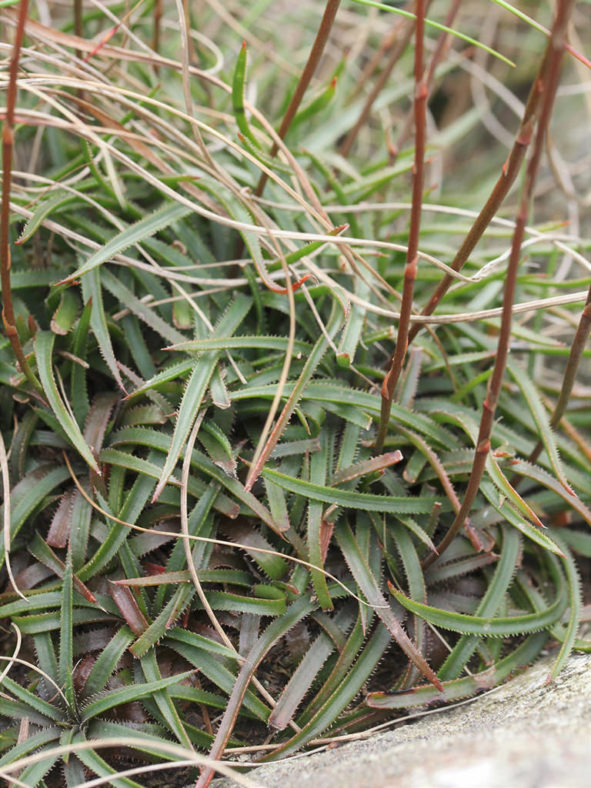Scientific Name
Aloe saundersiae (Reynolds) Reynolds
Synonym(s)
Leptaloe saundersiae
Scientific Classification
Family: Asphodelaceae
Subfamily: Asphodeloideae
Genus: Aloe
Etymology
The specific epithet "saundersiae (son-DER-see-ay)" honors Katharine Saunders (1824–1901), a British-born South African botanical illustrator.
Origin
Aloe saundersiae is native to South Africa. It grows in rock crevices or flat exposed places in rich sandy soil between tufts of short grass in central parts of KwaZulu-Natal.
Description
Aloe saundersiae is a small succulent with green, narrowly linear leaves arranged in stemless rosettes. It can grow up to 3 inches (7.5 cm) tall, either solitary or forms rosettes grouped in a small tuft. The leaves can measure up to 4 inches (10 cm) long and about 0.1 (0.3 cm) wide. The margins of the leaves have white, relatively soft, deltoid teeth up to 0.2 inches (0.5 cm) long.
The flowers appear in summer. The inflorescence is simple and erect with capitate racemes of cream-colored or pale pink flowers. The inflorescence can grow up to 17.2 inches (18 cm) tall, while the flowers can reach up to 0.5 inches (1.3 cm) in length.
Aloe saundersiae is a member of the group of Aloes with a grass-like appearance, commonly known as Grass Aloes.

How to Grow and Care for Aloe saundersiae
Light: When growing A. saundersiae indoors, place your plant in a window with plenty of bright indirect sunlight. Rotate the pot once or twice a week so that all sides of the plant receive equal lighting. Outdoors provide light shade, especially during the hottest parts of the day.
Soil: Plant A. saundersiae in a well-drained soil mix specially formulated for succulents or make your own. Drainage is essential because too much moisture around roots can cause root rot.
Hardiness: When temperatures shift below 50 °F (10 °C), it is time to bring your plant back inside. A. saundersiae can withstand temperatures as low as 25 to 50 °F (-3.9 to 10 °C), USDA hardiness zones 9b to 11b.
Watering: This succulent does need regular watering but is very tolerant of drought conditions for short periods. Water deeply, but only when the soil is dry. Cut back on watering during the winter months. Do not let water stand in the rosettes.
Fertilizing: A. saundersiae generally does not require fertilizer but may benefit from the extra nutrients. Feed with a fertilizer for succulents in spring and summer only. Be sure to follow the label directions.
Repotting: This plant is not particularly fast-growing and will only rarely need repotting. Repot it in the spring in a container a few inches larger in diameter every few years to keep it from becoming rootbound.
Propagation: Propagating A. saundersiae can be done by offsets, cuttings, or seeds from a mature plant. Remove offsets from the mother plant or take cuttings with a sharp knife in late spring or early summer. For best results, sow seeds during the warm months.
Learn more at How to Grow and Care for Aloe.
Toxicity of Aloe saundersiae
A. saundersiae is not listed as toxic for people and pets.
Links
- Back to genus Aloe
- Succupedia: Browse succulents by Scientific Name, Common Name, Genus, Family, USDA Hardiness Zone, Origin, or cacti by Genus
Photo Gallery
Click on a photo to see a larger version.


